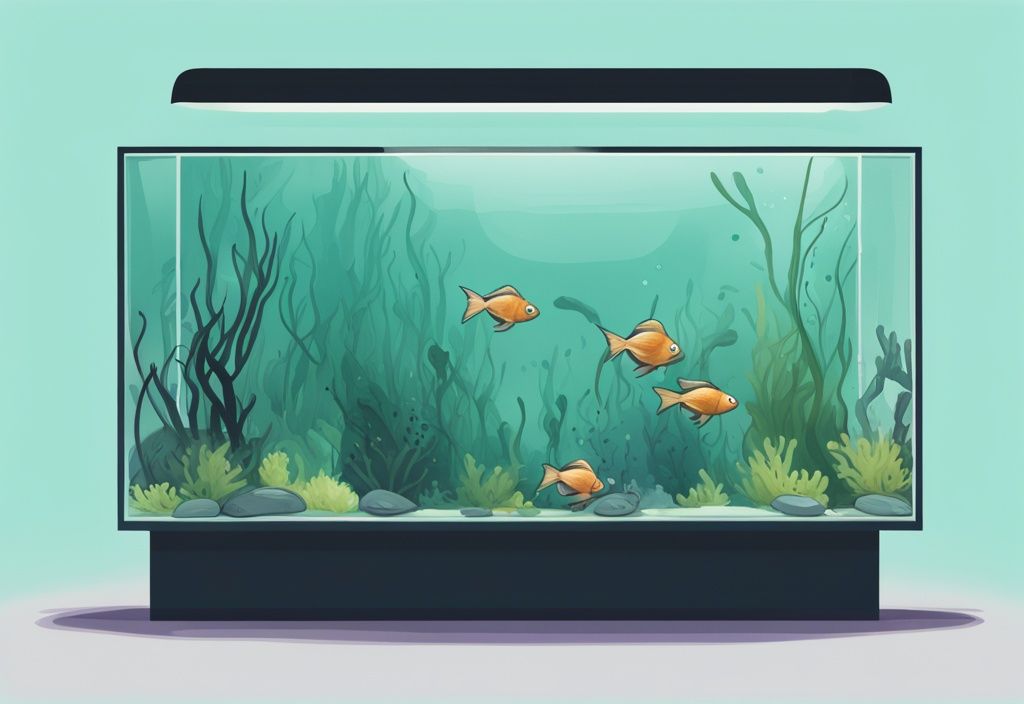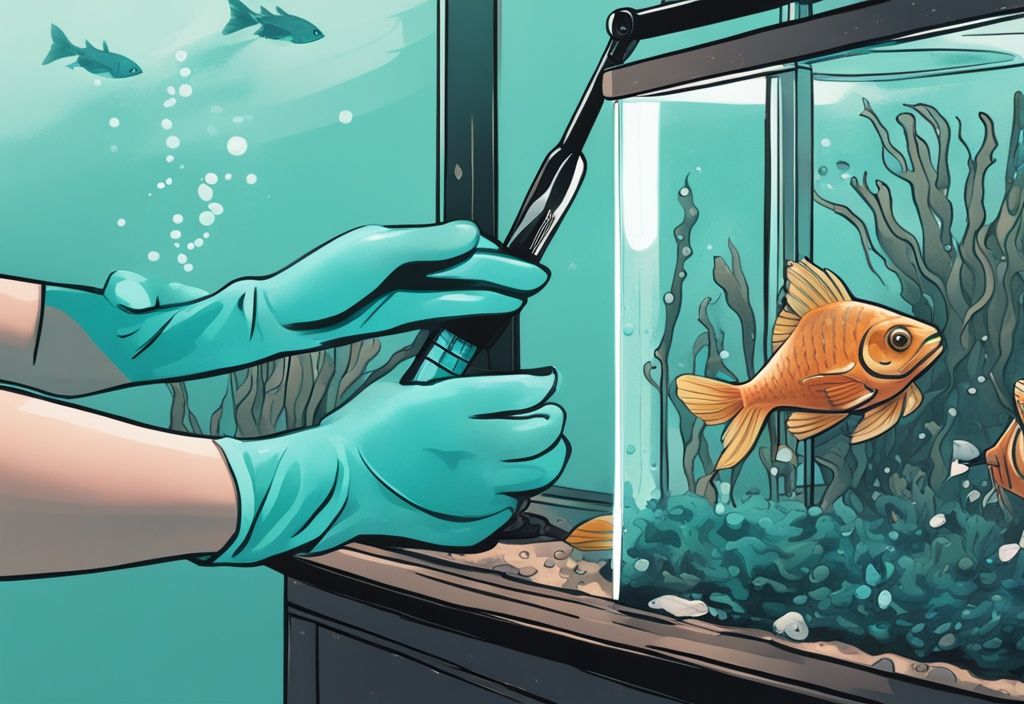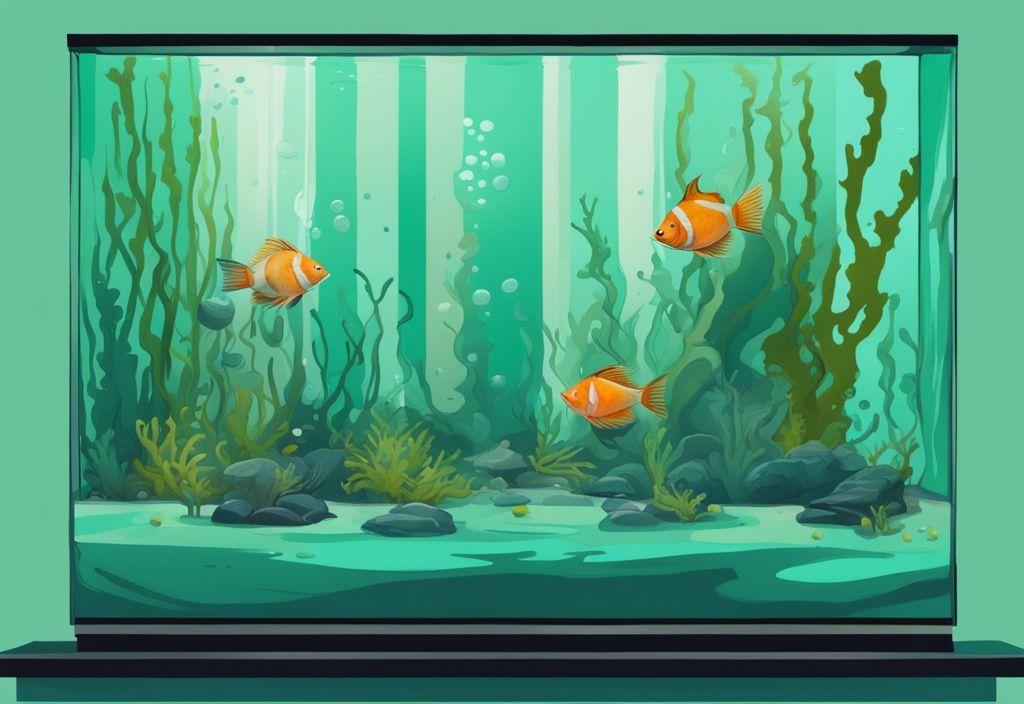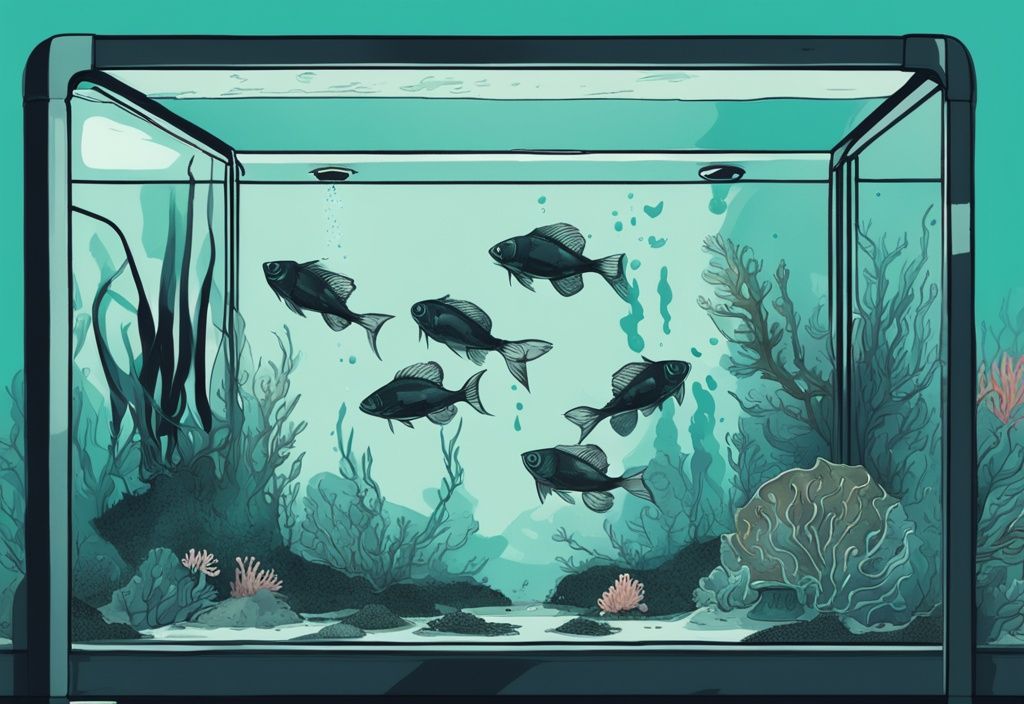Are you frustrated with stubborn black algae invading your beloved fish tank? This guide is here to help! As a professional marine biologist, I’ve battled this nuisance many times. Black algae, commonly known as black beard algae, can turn your beautiful underwater oasis into an unsightly, unhealthy environment for your little aquatic friends.
Understanding how to identify black algae and its causes is crucial to its elimination. In this comprehensive article, we’ll explain these factors and offer effective solutions ranging from hands-on removal techniques to sophisticated tech-based approaches.
So, gear up for an in-depth exploration into restoring balance to your tank. Our comprehensive guide ensures that by the end, you’ll know exactly how to maintain a vibrant, algae-free aquarium where your fish can thrive happily.
Identifying Black Algae in Your Tank
Managing black algae in your aquarium can be quite a task, but with the right approach and understanding, it becomes much more manageable. This section will help you recognize and tackle this pesky problem, ensuring a healthier environment for your aquatic friends.
What is Black Algae?
Black algae, often referred to as black beard algae (BBA), are notorious for their persistent nature in aquariums. These pesky algae outbreaks are usually a sign of imbalanced water parameters and poor water quality. Characterized by their rapid growth, black algae flourish in aquariums with high levels of phosphates and nitrates, excessive lighting, and too little CO2.
When these conditions are met, black algae can quickly spread across various surfaces. Whether it’s the glass walls, substrate, or decorations, they don’t discriminate. Their presence can be a significant headache, making maintenance a challenge and removal even more so.
Visual Characteristics of Black Algae
Identifying black algae visually is quite straightforward once you know what to look for. Initially, they appear as tiny black spots that gradually merge into larger patches. These patches have a distinct, tough texture and can look a bit fuzzy—imagine tiny beard-like tufts gripping the surfaces.
You’ll often find them clinging stubbornly to surfaces such as the tank glass, substrate, decorative items, and even on live plants. Because of their resilient nature, removing black algae usually requires some elbow grease and specific cleaning techniques.
Where to Look for Black Algae
To effectively combat black algae, you must conduct a thorough inspection of all possible surfaces in your tank. Start with the tank glass, substrate, decorations, and plants. Pay close attention to areas of strong water flow since black algae prefer these high-movement zones.
Additionally, don’t ignore the less illuminated parts of your tank. Sometimes, algae can thrive even in lower light conditions. Regular inspection of these areas ensures you can catch and manage black algae early, preventing it from escalating into a more prominent problem.
By maintaining a keen eye on your tank’s conditions and surfaces, you can effectively control black algae, creating a more balanced and healthier environment for your aquarium inhabitants.

Understanding Why Black Algae Is a Problem
Common Causes of Black Algae
Figuring out how to get rid of black algae in a fish tank begins with understanding what causes it in the first place. One primary factor is the high levels of phosphates and nitrates in the water. These compounds serve as nutrients for the algae, fostering its growth. To combat this, regular testing and water changes can help maintain these levels within an acceptable range.
Excessive light exposure is another common issue. When tank lighting remains on for too many hours or direct sunlight hits the tank, it can stimulate algae growth. Monitoring the lighting regimen in your tank is crucial.
Ideally, keep it limited to 8-12 hours per day and eliminate any direct sunlight exposure.
To ensure the best environment for your aquatic life, it’s crucial to understand how to cycle a fish tank, which helps maintain balanced water conditions. Low CO2 levels create an imbalance in the tank, making it easier for black algae to thrive. Ensuring adequate carbon dioxide levels can be a game-changer.
This might involve using CO2 injection systems or liquid carbon supplements. The focus here is on creating a balanced environment that doesn’t favor algae over your aquatic plants and fish.
Poor water quality management, such as irregular cleaning and maintenance routines, also plays a significant role in black algae growth. Consistent tank maintenance is crucial. This includes regular water changes, cleaning the substrate, and washing filters. By maintaining a disciplined routine, you can significantly reduce the chances of black algae becoming a problem.
Keys to Preventing Black Algae Formation
When addressing the challenge of how to get rid of black algae in fish tanks, focusing on prevention is key. Maintaining the right conditions can deter this pesky invader from ever taking hold. Here, we break down the essential methods.
Controlling Nutrient Levels and Light Exposure
To effectively tackle black algae in your aquarium, limiting light exposure and regulating nutrient levels are paramount. Start by setting your tank light to a duration of 8-12 hours a day. You might find a programmable timer to be an invaluable tool in keeping this schedule consistent. Blocking out direct sunlight that could inadvertently increase the tank’s brightness is another crucial step.
Once your lighting is under control, regularly test water parameters. Pay special attention to phosphates, nitrates, and CO2 levels. High levels of phosphates and nitrates can act as a feast for algae, while low CO2 levels disrupt the balance, creating a more favorable environment for algae growth. Balancing these elements makes your tank less hospitable to black algae.
Feeding Your Fish Properly
Feeding practices are equally important in managing black algae. Overfeeding is a common pitfall that leads to leftover food decomposing and releasing excess nutrients into the water, fostering algae growth. Ensure you feed your fish only what they can eat within a few minutes.
Establishing a consistent feeding schedule helps prevent nutrient spikes that can fuel algae proliferation. By rigorously maintaining these feeding habits and promptly removing uneaten food, you help keep nutrient levels in check, thereby reducing the risk of black algae formation.
Balancing these environmental factors not only keeps black algae at bay but also ensures a healthier and more vibrant aquatic ecosystem for your fish. By integrating these practices into your routine, you build a robust defense against black algae.

Effective Methods to Get Rid of Black Algae
Manual Removal Techniques
Getting rid of black algae in a fish tank often starts with manual removal, a straightforward yet labor-intensive process. Imagine you’re the surgeon, meticulously clearing a battlefield. One effective technique involves using an algae brush or razor blade to scrape off the algae from the tank glass. It’s like wielding a precise scalpel, reaching the stubborn spots where algae cling determinedly.
For decorations and plants, a trusty toothbrush can be your best ally. Its bristles act as tiny fingers that can reach into the crevices and textured surfaces where algae often thrive. After manually removing as much algae as possible, performing partial water changes becomes essential. This step ensures that all dislodged algae particles are flushed out of the water, preventing them from settling elsewhere in the tank and causing more trouble.
Safe Use of Chemical Treatments and Algaecides
In some cases, chemical treatments and algaecides are potent methods to combat black algae in a fish tank. Before diving into chemical warfare, ensure that the chosen algaecide is safe for all tank inhabitants, including fish and plants. One popular method involves using hydrogen peroxide, which can be applied directly to algae spots.
A diluted ratio of 1 part hydrogen peroxide to 150 parts water often proves effective for treating specific areas without causing significant harm to the tank’s ecosystem. Always exercise caution with chemical treatments, closely monitoring their long-term impacts on the tank environment. Proper dosage and application are key to ensuring these methods provide a beneficial outcome without adverse effects.
Tech-Based Solutions: UV Filters and Phosphate Removers
Embracing technology offers several solutions for controlling black algae in a fish tank. Installing a UV filter is an excellent way to tackle free-floating algae and prevent algae blooms. The UV light acts like a microscopic incinerator, neutralizing algae particles and stopping their reproduction.
In addition, using phosphate remover media within the tank filter can significantly reduce phosphate levels, one of the primary nutrients algae feed on. Regular maintenance of the aquarium filter is also crucial. Cleaning it in tank water ensures it continues to operate efficiently, further reducing the likelihood of algae growth.
Combining these tech-based solutions can help create a balanced and algae-resistant tank environment, resembling an ever-vigilant automated defense system.
Importance of Maintaining a Balanced Fish Tank Environment
Maintaining a balanced fish tank environment is essential for various reasons, all of which contribute to preventing issues like black algae and promoting a healthy aquatic ecosystem. Let’s dive into some practical strategies.
Regular Aquarium Maintenance and Water Testing
Regular maintenance routines are your frontline defense against black algae in your fish tank. A meticulously clean tank helps deter algae growth by minimizing nutrient imbalances. For more insights on maintaining pristine water quality in your aquarium, check out this comprehensive guide on mastering water quality management for a healthy aquarium. Start by performing consistent water changes and thorough gravel cleaning. Aim to replace around 10-20% of the water weekly. During these changes, use a vacuum to clean the substrate, effectively removing hidden debris and detritus, which can otherwise fuel algae formation. For detailed guidance, check out our tips on how to clean aquarium sand to ensure a healthier environment for your aquatic life.
Testing water parameters frequently is equally vital. Key indicators such as pH levels, ammonia, nitrites, and nitrates need close monitoring. Reliable testing kits can flag potential issues before they escalate, allowing you to make necessary adjustments. Regularly testing the water, ideally once a week, keeps you informed of any fluctuations. If you spot early signs of black algae, like small black spots or patches, take immediate action. Prompt intervention can prevent these unwelcome guests from becoming a persistent problem.
Enhancing Your Tank with Live Plants and Programmable LED Lights
Integrating live plants and programmable LED lights into your aquarium significantly helps in combating black algae. Live plants are natural competitors for the nutrients that algae thrive on. Consider adding broad-leafed plants like Anubias or Amazon Swords; they are excellent at outcompeting algae due to their large surface area and robust growth. Use high-quality plant supplements to maintain the health and growth of these plants, creating a more balanced ecosystem and stabilizing water parameters.

Lighting is a critical aspect in controlling algae growth. Programmable LED lights can offer a strategic advantage. These LEDs allow you to control the duration and intensity of light in the tank. Set the lights to mimic a natural environment by providing light for 8-12 hours a day. Programmable timers ensure consistency, reducing the chance of human error. Moreover, LEDs stay cooler than traditional lights, helping to maintain the tank’s balance without adding excess heat.
Conclusion
Learning how to get rid of black algae in a fish tank effectively demands a multifaceted approach, combining both preventive measures and active treatments. Persistence is essential, as combating black algae can often be a prolonged process. This persistent issue won’t resolve overnight; rather, it requires dedicated and ongoing effort.
To tackle black algae, a combination of manual removal and chemical treatments may be necessary. Manual techniques like scraping algae from tank surfaces and brushing it off decorations can yield immediate, though temporary, relief. If you are considering relocating your aquarium, you might want to learn how to move a fish tank safely to prevent disturbing the environment. Following these methods with partial water changes helps remove suspended algae particles, improving overall water quality.
Incorporating chemical treatments cautiously can also be part of the strategy. It’s vital to choose algaecides that are safe for the tank inhabitants. For more targeted solutions, consider using diluted hydrogen peroxide to treat specific algae spots. Furthermore, tech-based solutions, such as installing UV filters and utilizing phosphate removers, can support long-term algae management by maintaining cleaner water and reducing nutrient levels that fuel algae growth.
Maintaining a balanced tank environment is paramount. Regular aquarium maintenance, like consistent water changes and mechanical filtration, ensures clean water. Routine testing and balancing of water parameters prevent conditions that favor algal blooms. Proper feeding practices minimize nutrient accumulation, and controlled lighting reduces excessive light exposure, both of which are crucial in preventing algae recurrence.
By understanding how to get rid of black algae in a fish tank and persistently applying these strategies, you uphold a thriving and visually appealing aquatic environment. Implementing these measures fosters a balanced ecosystem where fish and plants can flourish without the persistent nuisance of black algae.
FAQ
How often should I clean my fish tank to prevent black algae?
Black algae can be quite a nuisance, but regular cleaning can keep it at bay. Aim to clean your tank at least once a week or bi-weekly. Consistently perform partial water changes, aiming to change 10-20% of the water each week. This routine helps maintain water quality and reduces the nutrients that black algae love to thrive on.
Are chemical treatments safe for fish and plants?
Chemical treatments can be a helpful ally in combating black algae. When used correctly and chosen based on your tank’s specific needs, they can be safe. Always follow the manufacturer’s guidelines closely and consider the wellbeing of your tank’s inhabitants. Be mindful that overuse or improper application of chemicals can be detrimental to both fish and plants.
What types of algae eaters are most effective?
Incorporating algae eaters into your tank can significantly help control black algae. Some of the most effective include Siamese Algae Eaters, Otocinclus Catfish, Amano Shrimp, and certain snail species. However, it’s essential to ensure compatibility with your existing fish species before introducing any new inhabitants to avoid conflicts and to ensure they thrive.
Can black algae harm my fish?
Black algae itself isn’t directly harmful to fish, but it can be an indicator of suboptimal tank conditions. Algal overgrowth can lead to decreased water quality, which can stress your fish and make them more prone to diseases. Regular and thorough tank maintenance is crucial to prevent such issues and keep your aquatic friends healthy and happy.
